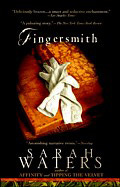Set in the early 1860s, Fingersmith is an atmospheric Gothic novel about two young women. Susan has been trained as a "fingersmith" - a pickpocket - by an indulgent surrogate mother, and raised in a household in the London slums which traffics in stolen goods and orphaned infants. Maud, an heiress, lives in the isolated, run-down country manor of a coldly eccentric uncle who requires her to help him catalog his library.
They meet when a charming thief lures Susan into a scheme to persuade Maud to marry him so he can abscond with her inheritance. Posing as a lady's maid, a position for which she is utterly unqualified, Susan arrives at the desolate manor and soon begins to suffer qualms about cheating the vulnerable, friendless Maud, who suffers from nightmares. Susan's routine soon includes sleeping in Maud's bed.
Although the plot moves slowly in the early part of the novel, plenty of oddities will keep readers wondering: What are the books Maud’s old uncle guards so fiercely? Why does Maud insist on wearing gloves at all hours? Why, when she so obviously yearns to be freed from her uncle's suffocating house, is she so reluctant to elope with Mr. Rivers?
Women in nineteenth-century England had almost no legal rights independent of their husbands or male relatives. A married woman's income, whether inherited or earned by her own labor, legally belonged to her husband. Except under rare circumstances, a woman could not divorce her husband. If she fled an unhappy marriage she could be forced back into the custody of a husband who had the right to beat or imprison her. Sex was not spoken of in polite society, but the desires of men fueled a thriving subterranean economy. As the plot of Fingersmith gathers steam from these unhappy historical realities, it becomes a relentless page-turner. (2002, 583 pages including an Acknowledgements that lists sources for the history behind the story)




